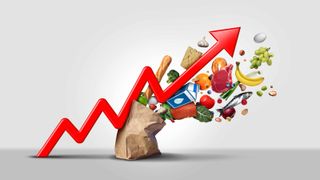Rising Prices: Which Goods and Services Are Driving Inflation?
Higher prices for energy, medical care and select other items contributed to hotter-than-expected inflation in March.


Inflation accelerated once again last month, exceeding economists' expectations in a number of key categories, according to the latest Consumer Price Index.
Headline inflation rose 0.4% in March, the Bureau of Labor Statistics said Wednesday, exceeding economists' forecast for a 0.3% increase. On an annual basis, headline inflation increased 3.5%. That was up from 3.2% a month ago and topped estimates for a 3.1% print.
Core CPI, which strips out volatile food and energy costs and is considered a better predictor of future prices, hit 0.4% month-to-month – just as it did the preceding two months. Economists were looking for core prices to increase just 0.3%. On an annual basis, core CPI rose 3.8%, as it did the prior month, vs expectations for a 3.7% increase.

Sign up for Kiplinger’s Free E-Newsletters
Profit and prosper with the best of expert advice on investing, taxes, retirement, personal finance and more - straight to your e-mail.
Profit and prosper with the best of expert advice - straight to your e-mail.
"Today's inflation number was mostly driven by higher energy prices, medical care services and motor vehicle insurance," says Sonu Varghese, global macro strategist at Carson Group. "There were encouraging signs under the hood, as shelter continues its disinflation trend, food inflation eases and commodity prices outside energy and food pull back."
The bottom line from the March CPI report is that prices are still rising at rates not seen in generations.
Between 2000 and 2020, annual inflation in the U.S. averaged just 2.1%. (Recall that the Federal Reserve's inflation target is 2%.) Perhaps we didn't appreciate it enough at the time, but the first two decades of the 21st century were a sort of Goldilocks era for inflation: not too fast and not too slow.
Just have a look at some of the subcategories in the latest CPI report to see how much things have changed. Below we highlight the goods and services that are weighing most heavily on folks' finances.
Rising prices: where inflation is hitting hardest

Energy inflation cooled last month, but still continued apace, rising 1.1%. Over the past year, energy prices are up 2.1%. March's energy increase was driven partly by a 1.7% increase in the index for gasoline, and a 0.7% increase in electricity.
Inflation in services excluding energy services rose 0.5% in March after rising by the same amount the previous month. Over the past year, the services ex-energy index gained 5.4%.
Shelter or housing, which accounts for about two-thirds of the CPI weighting and moves with a lag, was less to blame for the nasty upside inflation surprise than last month; but it still hurt. The sundry costs for keeping a roof over one's head, remained at 0.4% last month. On an annual basis, shelter costs popped 5.7%.
True, home prices and rents are basically back to where they were in June 2022, but adjustments to owners' equivalent rent and the fact that the data are backward looking are just a couple of reasons for this CPI component remaining elevated.
Other goods and services seeing an acceleration in monthly inflation included apparel, transportation services and medical care services.
In better news, buyers of used vehicles caught a break in March, as prices declined by 1.1% after rising 0.5% the previous month.
Although upward price pressures continue to show signs of easing, experts stress the fight against inflation is far from over.
Related Content

Dan Burrows is Kiplinger's senior investing writer, having joined the august publication full time in 2016.
A long-time financial journalist, Dan is a veteran of SmartMoney, MarketWatch, CBS MoneyWatch, InvestorPlace and DailyFinance. He has written for The Wall Street Journal, Bloomberg, Consumer Reports, Senior Executive and Boston magazine, and his stories have appeared in the New York Daily News, the San Jose Mercury News and Investor's Business Daily, among other publications. As a senior writer at AOL's DailyFinance, Dan reported market news from the floor of the New York Stock Exchange and hosted a weekly video segment on equities.
Once upon a time – before his days as a financial reporter and assistant financial editor at legendary fashion trade paper Women's Wear Daily – Dan worked for Spy magazine, scribbled away at Time Inc. and contributed to Maxim magazine back when lad mags were a thing. He's also written for Esquire magazine's Dubious Achievements Awards.
In his current role at Kiplinger, Dan writes about equities, fixed income, currencies, commodities, funds, macroeconomics, demographics, real estate, cost of living indexes and more.
Dan holds a bachelor's degree from Oberlin College and a master's degree from Columbia University.
Disclosure: Dan does not trade stocks or other securities. Rather, he dollar-cost averages into cheap funds and index funds and holds them forever in tax-advantaged accounts.
-
 Save Over $40 on Audible With Amazon's Latest Deal
Save Over $40 on Audible With Amazon's Latest DealAmazon’s latest promotion lets you score three months of Audible for just $0.99 a month.
By Erin Bendig Published
-
 Buy eBay and Sell Etsy, Morgan Stanley Says
Buy eBay and Sell Etsy, Morgan Stanley SaysMorgan Stanley is bullish on eBay and bearish on Etsy. Here’s what you need to know.
By Joey Solitro Published
-
 Buy eBay and Sell Etsy, Morgan Stanley Says
Buy eBay and Sell Etsy, Morgan Stanley SaysMorgan Stanley is bullish on eBay and bearish on Etsy. Here’s what you need to know.
By Joey Solitro Published
-
 Why Taiwan Semiconductor Stock Is Falling After Earnings
Why Taiwan Semiconductor Stock Is Falling After EarningsTaiwan Semiconductor beat expectations for the first quarter but its stock is notably lower. Here's why.
By Joey Solitro Published
-
 Starbucks BOGO and New Sweet and Spicy Drinks
Starbucks BOGO and New Sweet and Spicy DrinksFor a limited time, Starbucks is announcing four new "swicy" drinks that are both spicy and sweet.
By Kathryn Pomroy Published
-
 Stock Market Today: Dow Slips After Travelers' Earnings Miss
Stock Market Today: Dow Slips After Travelers' Earnings MissThe property and casualty insurer posted a bottom-line miss as catastrophe losses spiked.
By Karee Venema Published
-
 Why United Airlines Stock Is Flying Higher After Earnings
Why United Airlines Stock Is Flying Higher After EarningsUnited Airlines beat expectations for the first quarter and its stock is by soaring. Here's what you need to know.
By Joey Solitro Published
-
 Super Micro Computer: Why This Hot Stock Could Hit $1,500
Super Micro Computer: Why This Hot Stock Could Hit $1,500Super Micro Computer's long-term AI revenue potential is underappreciated, Loop Capital says. Here's what you need to know.
By Joey Solitro Published
-
 Stock Market Today: Stocks Stabilize After Powell's Rate-Cut Warning
Stock Market Today: Stocks Stabilize After Powell's Rate-Cut WarningThe main indexes temporarily tumbled after Fed Chair Powell said interest rates could stay higher for longer.
By Karee Venema Published
-
 What Does Tesla Stock's Latest Slide Mean for Investors?
What Does Tesla Stock's Latest Slide Mean for Investors?Tesla stock is down more than 35% in 2024 and the company just announced layoffs. Here's what you need to know.
By Joey Solitro Published